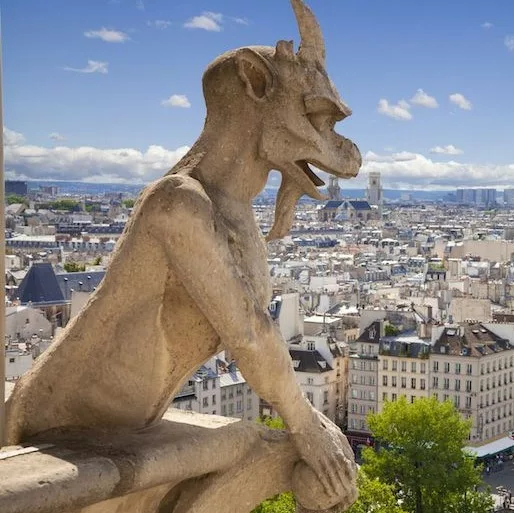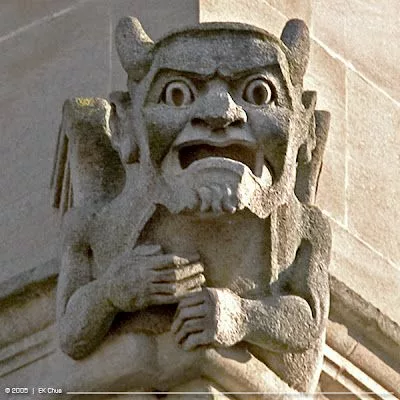Gargoyles, whether made of real or cast stone, have always captured the human imagination, appearing both ominous and fascinating. These stone creatures, perched high above us, have their roots deep in the historical fabric of medieval architecture.
The term “gargoyle” comes from the Old French word “gargouille,” which means throat. This hints at their original function as spouts designed to direct rainwater away from buildings. However, their purpose isn’t just functional; gargoyles are a blend of engineering and art, a testament to the skill of medieval stonemasons.

As an Amazon Associate, I earn from qualifying purchases.
This post contains affiliate links. If you make a purchase through these links, I may earn a commission at no extra cost to you.
Evolving out of necessity, gargoyles became integral parts of Gothic cathedrals. Their ability to serve practical purposes while doubling as captivating embellishments added layers of complexity to the architectural designs of the time.

Beyond practicality, gargoyles also held cultural significance. In medieval society, they were believed to ward off evil spirits, a symbolic guardian of sorts encased in beautiful, albeit frightening, forms.
These stone guardians effectively combined artistry with utility, creating an architectural feature that transcends function. While rooted in the past, the mystique surrounding gargoyles continues to influence modern architectural designs, proving their timeless allure.
Dual Functions: Water Spouts and Artistry in Stone
The original raison d’être for gargoyles was surprisingly practical. Gargoyles are much more than just spooky decor on ancient buildings. Their original and primary purpose was to function as water spouts. Perched high on cathedrals and buildings and before the invention of modern drainage and guttering systems, these stone-crafted creatures had the vital job of channeling rainwater away from a building’s walls and foundations, thus preventing water damage like erosion or damp penetration.
The artistry involved in crafting and designing gargoyles went hand-in-hand with their utilitarian function. Craftsmen took the liberty to carve them into grotesque and imaginative figures, giving each piece a unique character harmonizing utility with aesthetic appeal.
While their practical role as drainage devices dictated elements of a gargoyle’s design considerations like their elongated bodies or mouths positioned perfectly for spouting water from their exacting positioning on a building. The artistic masons didn’t shy away from adding intricate details. This marriage of engineering needs with creative expression is what makes gargoyles genuinely fascinating and their unique silhouettes are recognized throughout history.
In today’s world, although we don’t rely on gargoyles as necessary elements of a building’s drainage, they still serve as decorative features that echo historical designs. Modern versions can even be adapted into water spouts again, or just as covers for the more commonly used scupper outlets on roofs. This then blends historical allure with contemporary function.
When incorporating gargoyles into a design, it helps to think about the historical and visual impact they offer as well as the angles, placement, and flow dynamics when a gargoyle performs as an artistic water feature. Even in modern settings, they still carry the potential to combine practicality with a nod to history, ensuring both form and function are beautifully met.
Icons of Architecture: Key Historical and Modern Examples
Gargoyles have populated the facades of some of the most iconic architectural works, acting as both protectors and ornaments. Perhaps the most famous set of gargoyles are those gracing the Notre Dame Cathedral in Paris. These stone carvings exemplify the Gothic approach to detail and drama, featuring chimeras and angels that seem alive despite their stone skin.
During the medieval period, these architectural adornments transcended mere decoration. They expressed the height of craftsmanship, capturing an eerie beauty unique to this era. While they’re often associated with medieval Europe, their influence spans various periods.
The Renaissance saw a shift in architectural tastes, where gargoyle designs began embracing more classical elements. The grotesques found during this time merged traditional motifs with emerging humanistic ideas, reflecting a blend of the old and the new in design. This period introduced softer lines and sometimes even incorporated mythological influences, evident in the architecture of Renaissance Italy.
In more recent times, modern architecture has given rise to creative interpretations of gargoyles. Buildings around the world continue to incorporate these mystical figures, either through contemporary adaptations or maintaining traditional styles. Modern-day architects often use them to add a touch of historical intrigue or whimsical flair to their projects.
For anyone considering adding a hint of gargoyle grandeur to a project, understanding the historical examples offers a wealth of inspiration. Whether you lean towards the gothic austerity of medieval designs or prefer the classical elegance of the Renaissance, there’s a gargoyle style to suit every architectural vision.
Gargoyles in Culture: Grotesque and Popular Interpretations
The charm and mystery of gargoyles extend far beyond their architectural roots, spilling into the realm of cultural symbolism where they take on grotesque and fantastical forms. The term ‘grotesque’ itself is deeply tied to these creatures, describing figures that are bizarre, unusual, and even disturbing.
Originating in Roman decorative art, the grotesque represents a world of exaggerated forms and hybrid creatures that defy the normal—figures meant to invoke a sense of wonder mingled with unease. Gargoyles played into this concept, often displaying exaggerated facial expressions, twisted bodies, and mythical features.
These peculiar forms were more than mere decorative indulgences. They carried significant symbolic meaning, often thought to ward off evil spirits. This ties back to deep-seated superstitions and cultural beliefs where these stone caricatures served as protectors, looming figures meant to inspire awe and perhaps a bit of trepidation.
Beyond their symbolic roles, gargoyles and grotesques have permeated pop culture. They appear in literature, art, and film, evolving from their medieval origins into modern-day icons that fuel the imagination. Whether in horror movies or fantasy novels, gargoyles provide a bridge between historical intrigue and narrative storytelling.
For those interested in medieval lore, incorporating elements of the grotesque into contemporary art or design can add a unique edge. Consider them as conversation starters—they’re not just ornamental features, but storytellers in stone, whispering tales of old that still capture imaginations today.
Gargoyles in Popular Culture: Legacy and Interpretation
Gargoyles have stepped down from their stone perches and into the imagination of modern culture. They’re no longer just architectural fixtures but have become stars in their own right across various forms of media. Their intrigue makes them popular figures in literature, film, and even video games, where their mysterious and ancient aura adds layers to storytelling.
In the literary world, gargoyles often feature in fantasy stories, sometimes depicted as protectors or animated beings coming to life under magical circumstances. Authors use them as characters with their own narratives, freeing them from their stone-bound origins and giving them agency and voice.
The film industry, too, capitalizes on the dramatic and eerie presence of gargoyles. From horror flicks to adventure movies, these characters are often used to emphasize the mood of a scene or represent hidden forces at play.
Beyond fiction, gargoyles inspire art installations and public sculptures, bridging the gap between myth and modern design. They pop up in cityscapes around the world, combining modern techniques with traditional forms to create pieces that are both familiar and new.
Their symbolism continues to thrive as a popular motif in merchandise, from jewelry to home decor. This adaptability shows how gargoyles have transcended their original purposes, evolving into a versatile emblem of mystery and protection that’s appreciated in diverse contexts.
For anyone looking to incorporate gargoyles into their creative projects, whether it be in art, design, or storytelling, there’s a rich tapestry of cultural reverence to draw from. Embrace their legacy of mystery and embrace the playful yet profound impact they can offer.
The Enduring Legacy of Gargoyles
Today Gargoyles are made with different products, Rarely are they hand-carved from natural stone, they are more commonly first made as a model in softer materials that are far easier to work with. Any mistakes can be easily covered up and when the model is to the artists or clients liking a mold is made. These molds are made in much the same way as other more detailed or complex cast stone molds.
The final model would be prepared to a quality surface finish so as to reflect the same in the final mold surface. The most common choice for molding material would be a good quality 2-part silicone. This mold would have a durable outer shell mold made of fiberglass or a hard plastic, and easily dismantled. By making a quality mold many of the same pieces can be made helping to amortize the original mold costs.
With this method of manufacturing is is also far easier to add a water way if needed through the piece. Even electrics for a modern day light or security camera.
Choosing the casting mix can be as important as the mold. A great quality mix with the right-sized aggregates and colored pigments will produce a perfect replica of the original piece looking like real stone.
Gargoyles, with their haunting presence and historical significance, continue to captivate us even as architectural practices evolve. They stand as enduring symbols of the intricate dance between beauty and functionality, where art meets necessity.
These stone figures are not mere relics of the past but vibrant participants in the narrative of modern culture and architecture. Each gargoyle, whether crouched on a cathedral’s edge or evoked in a piece of contemporary art, tells a story that bridges centuries.
Their ability to evoke wonder and curiosity is timeless, making them relevant in today’s world as much as they were in medieval Europe. For architects and designers, incorporating gargoyle motifs can add a layer of historical intrigue and narrative depth to modern projects.
For enthusiasts and collectors, gargoyles offer a tangible connection to an era when form and function harmonized in truly captivating ways. Adopting these figures into various facets of modern life—be it in literature, film, or art—ensures their stories and symbolism remain alive.
Embrace the stark beauty and profound history of gargoyles. Whether you’re exploring them as architectural elements or cultural symbols, they offer a rich terrain for creativity and expression. Their legacy is not just carved in stone; it’s etched into the fabric of imagination and storytelling.
Contact Us
We hope you find the information useful, but if you have any questions or need help, send us a message. You do have to sign in and confirm these days to comply with government rules. Sorry for the inconvenience.
Author Rob


This article dives deep into the fascinating history and cultural symbolism of gargoyles, explaining not only their original purpose as water spouts but also their evolution into icons of mystery and artistry. I found the exploration of how gargoyles have transitioned from medieval architecture to modern pop culture especially intriguing. It’s impressive how these stone figures have remained relevant across centuries, symbolizing both functionality and artistic expression. One question I have is about the use of gargoyles in modern architecture. Are there specific challenges or limitations architects face when incorporating such detailed designs today, particularly with regard to durability or materials?
Hi Amalthe, Thank you for your comments. Regarding your question of limitations, in today’s world I believe there are virtually no limitations, 3D printing lets the true extent of modelling shine through, and today’s complex compounds and mixes will last longer than ever.
Thank you
Rob